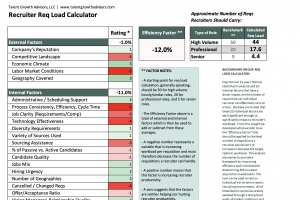Strategic Workforce Planning: Seven Steps To Driving Your Best Talent Acquisition Strategy

I realize it’s hard to find a more nebulous, misunderstood and possibly hated word in Human Resources other than “strategic workforce planning” (although “onboarding” might run a close second.)
However, after helping companies dramatically improve the speed and quality of hiring for more than 15 years, we’ve identified several keys to successfully improving hiring and retention results.
One of those is the (dreaded, for good reason) need to create a strategic workforce plan. This article describes why this is important, how to do it, and what results you should see.
Why Strategic Workforce Planning is Important to Talent Acquisition Success
Like with any effort, working without a concrete goal is a sure-fire way to not achieve desired results. Talent acquisition (TA) teams often have unclear goals. In fact, recruiters often tell us that their priorities are “to fill jobs fast” and “keep hiring managers happy.” This ambiguity is complicated by the fact that hiring priorities are difficult to identify.
Strategic workforce planning (SWP) – as it relates to talent acquisition – identifies future hiring needs and priorities aligned to business strategy. But it’s easier said than done. In many organizations, different senior leaders vie for top priority billing for their own needs. On the other hand, others believe that the most frequently hired roles, or those closest to the customers, are by default, most urgent to fill.
These debates are often outside of the purview of the Talent Acquisition team. In turn, the absence of strategic TA representation, the conversation – and decisions around hiring priorities and workforce strategy – can lose steam and fall off the HR planning agenda.
But here is why these decisions and priorities must be agreed upon widely in order for Talent Acquisition to ultimately succeed for the organization:
Understanding How Talent Drives Business Value
First, it’s important to understand the creation of business value: markets set a company’s business value based on reasonable projections of future cash flow driven by asset performance. There are two types of assets to consider. The first is tangible assets (equipment, buildings, trucks, etc. – all of which companies report). The second is intangible assets (brands, customer relationships, IP, proprietary technology – none of which companies report in their financials, unless they sell or acquire another company). Our research shows that over 90 percent of the value of leading companies is attributable to intangible assets, such as brands, proprietary data and software, IP, customer relations, etc. These assets that drive the vast majority of business value are created by nothing other than people.
90% of leading companies’ value is created by intangible assets – the only source of which is people.
It is an organization’s human capital that creates intellectual capital – intangible assets, which can be thought of as the valuable accumulations of employees’ intellectual output over time.
To measure the value of SWP and talent acquisition investments in a particular organization, one must first understand how value is created (and will be created) within that specific business. For public companies, a review of public documents such as investor presentations and 10-Ks provides a solid baseline understanding. It is easy to determine that for a company like Raytheon, a relatively small team of engineers creates the greatest amount of business value for the organization. For companies like Coca-Cola and Proctor & Gamble, it’s brand managers and product innovation professionals. For Merck, it’s the R&D team creating patentable new drugs. Great hires in these areas for these businesses will result in huge gains in business value. Poor hires, on the flipside, will create great risk. For this reason alone, strategic workforce planning is essential to identifying the most critical roles in the organization. Only in this way, can talent acquisition priorities be identified, can goals be established and resources deployed effectively.
Most Common Strategic Workforce Planning Mistake
Trying to build workforce plans across entire swaths of the business – by level, by geography – is typically too unwieldy to enable concrete, actionable priorities and next steps. Given the importance of critical roles in an organization, a key to success is starting with a very narrow targeted role or functional vertical. An example would be research, data analytics, merchandising or brand management. By prioritizing the most essential skills, workforce planning efforts deliver the most important information and action steps to key business areas first. Then one can methodically move on to other functional areas afterward.
Seven Steps to a Strategic and Targeted Workforce Planning Process
- Using the methodology described above, build a case for identifying the roles / skills that are most essential to creating future business value for the organization. Meet with several key business, talent management and HR leaders to get their understanding and buy in. You'll want to cover both the need for prioritizing workforce planning efforts and how you arrived on this particular group of jobs and skills.
- For this group of roles or functional area, collect the following:
- 1-2 years of hiring, attrition and internal movement data by role / employee
- Organizational charts
- Business plans for the function - short and long term
-
Analyze the data and prepare materials to conduct a half-day workshop with the senior leader and his or her direct reports.
-
Facilitate a half-day workshop with the leadership team to accomplish the following objectives:
- Overview the goals of the session – specifically, workforce planning and talent acquisition strategic priorities and plans
- Review their hiring and attrition trends for the prior 1-2 years to date
- Get the team’s input on specific replacement and new hiring needs and plans for the next 6-12 months
- Considering business goals and scenario planning, discuss and capture known high-level hiring needs beyond 12 months
- Facilitate a discussion about the criticality of the roles (or groups of roles) and the availability of talent in the marketplace for the skills required.
-
Post-session, roll up results for the group and identify talent priorities, estimated numbers, timing, and provisional approaches.
-
Develop the talent acquisition strategy required to find, attract and win the roles identified, beginning with those deemed most critical and requiring the scarcest skills available in the marketplace.
-
Set Talent Acquisition goals (speed, cost, quality, diversity) and targets by sourcing channel and align resources to execute plans to secure the future workforce.
The Hiring Results You Should See Resulting from Targeted and Strategic Workforce Planning
Numerous, concrete results should come from this work, including:
- Alignment among senior leaders and key stakeholders regarding workforce planning and talent acquisition priorities
- Specific list of hiring plans and priorities to revisit and update on a quarterly basis following the working session
- Assessment, by business leaders, of the criticality and availability of skills for their predicted openings
- Prioritized, data driven, talent acquisition forecasts and plans for the specific functional area
- Goals, tactics, and measures of success for the TA team for these targeted roles
Success in hiring isn’t possible without concrete goals. And goals can’t be business-based, accurate, measurable or value-added without targeted and strategic workforce planning.
Want to discuss workforce planning or examples of our work in this area? Contact us at info@talentgrowthadvisors.com
Share this Article
Learn more about our unique approach to Talent Strategy Formulation.



